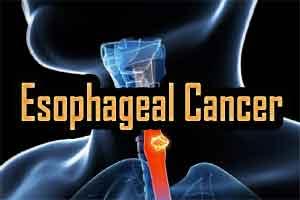- Home
- Editorial
- News
- Practice Guidelines
- Anesthesiology Guidelines
- Cancer Guidelines
- Cardiac Sciences Guidelines
- Critical Care Guidelines
- Dentistry Guidelines
- Dermatology Guidelines
- Diabetes and Endo Guidelines
- Diagnostics Guidelines
- ENT Guidelines
- Featured Practice Guidelines
- Gastroenterology Guidelines
- Geriatrics Guidelines
- Medicine Guidelines
- Nephrology Guidelines
- Neurosciences Guidelines
- Obs and Gynae Guidelines
- Ophthalmology Guidelines
- Orthopaedics Guidelines
- Paediatrics Guidelines
- Psychiatry Guidelines
- Pulmonology Guidelines
- Radiology Guidelines
- Surgery Guidelines
- Urology Guidelines
Oral bacteria may be linked to esophageal cancer: New study

Washington: Researchers have found that a bacterial species responsible for gum disease is present in 61% of patients with esophageal cancer.
The findings detected the bacterial species Porphyromonas gingivalis in 12% of tissues adjacent to the cancerous cells, while this organism was undetected in normal esophageal tissue. "These findings provide the first direct evidence that P gingivalis infection could be a novel risk factor for esophageal squamous cell carcinoma (ESCC), and may also serve as a prognostic biomarker for this type of cancer," said Huizhi Wang from the University of Louisville's School of Dentistry in US.
"These data, if confirmed, indicate that eradication of a common oral pathogen may contribute to a reduction in the significant number of people suffering with ESCC," said Wang.
The esophagus, a muscular tube critical to the movement of food from the mouth to the stomach, is lined with two main kinds of cells, thus there are two main types of esophageal cancer - adenocarcinoma and squamous cell carcinoma.
Researchers measured the expression of lysine-gingipain, an enzyme unique to P gingivalis, as well as the presence of the bacterial cell DNA within the esophageal tissues. Both the bacteria-distinguishing enzyme and its DNA were significantly higher in the cancerous tissue of ESCC patients than in surrounding tissue or normal control sites.
Researchers also found the presence of P gingivalis correlated with other factors, including cancer cell differentiation, metastasis and overall survival rate. According to the researchers, there are two likely explanations - either ESCC cells are a preferred niche for P gingivalis to thrive or the infection of P gingivalis facilitates the development of esophageal cancer.
If the first explanation is true, simple antibiotics may prove useful or researchers can develop other therapeutic approaches for esophageal cancer utilising genetic technology to target the P gingivalis and ultimately destroy the cancer cells, Wang said. "Should P gingivalis prove to cause ESCC, the implications are enormous. It would suggest that improving oral hygiene may reduce ESCC risk; screening for P gingivalis in dental plaque may identify susceptible subjects; and using antibiotics or other anti-bacterial strategies may prevent ESCC progression," said Wang.
The findings detected the bacterial species Porphyromonas gingivalis in 12% of tissues adjacent to the cancerous cells, while this organism was undetected in normal esophageal tissue. "These findings provide the first direct evidence that P gingivalis infection could be a novel risk factor for esophageal squamous cell carcinoma (ESCC), and may also serve as a prognostic biomarker for this type of cancer," said Huizhi Wang from the University of Louisville's School of Dentistry in US.
"These data, if confirmed, indicate that eradication of a common oral pathogen may contribute to a reduction in the significant number of people suffering with ESCC," said Wang.
The esophagus, a muscular tube critical to the movement of food from the mouth to the stomach, is lined with two main kinds of cells, thus there are two main types of esophageal cancer - adenocarcinoma and squamous cell carcinoma.
Researchers measured the expression of lysine-gingipain, an enzyme unique to P gingivalis, as well as the presence of the bacterial cell DNA within the esophageal tissues. Both the bacteria-distinguishing enzyme and its DNA were significantly higher in the cancerous tissue of ESCC patients than in surrounding tissue or normal control sites.
Researchers also found the presence of P gingivalis correlated with other factors, including cancer cell differentiation, metastasis and overall survival rate. According to the researchers, there are two likely explanations - either ESCC cells are a preferred niche for P gingivalis to thrive or the infection of P gingivalis facilitates the development of esophageal cancer.
If the first explanation is true, simple antibiotics may prove useful or researchers can develop other therapeutic approaches for esophageal cancer utilising genetic technology to target the P gingivalis and ultimately destroy the cancer cells, Wang said. "Should P gingivalis prove to cause ESCC, the implications are enormous. It would suggest that improving oral hygiene may reduce ESCC risk; screening for P gingivalis in dental plaque may identify susceptible subjects; and using antibiotics or other anti-bacterial strategies may prevent ESCC progression," said Wang.
Next Story
NO DATA FOUND

Disclaimer: This site is primarily intended for healthcare professionals. Any content/information on this website does not replace the advice of medical and/or health professionals and should not be construed as medical/diagnostic advice/endorsement or prescription. Use of this site is subject to our terms of use, privacy policy, advertisement policy. © 2020 Minerva Medical Treatment Pvt Ltd